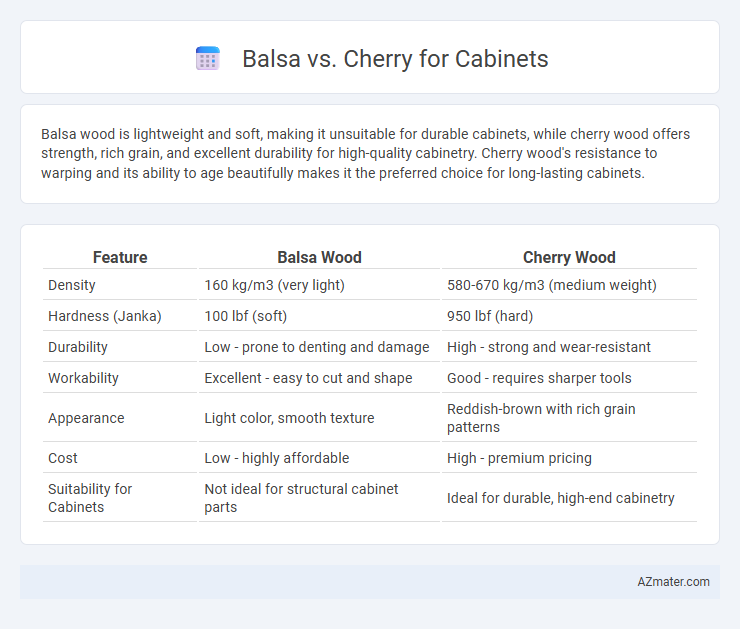Balsa wood is lightweight and soft, making it unsuitable for durable cabinets, while cherry wood offers strength, rich grain, and excellent durability for high-quality cabinetry. Cherry wood's resistance to warping and its ability to age beautifully makes it the preferred choice for long-lasting cabinets.
Table of Comparison
| Feature | Balsa Wood | Cherry Wood |
|---|---|---|
| Density | 160 kg/m3 (very light) | 580-670 kg/m3 (medium weight) |
| Hardness (Janka) | 100 lbf (soft) | 950 lbf (hard) |
| Durability | Low - prone to denting and damage | High - strong and wear-resistant |
| Workability | Excellent - easy to cut and shape | Good - requires sharper tools |
| Appearance | Light color, smooth texture | Reddish-brown with rich grain patterns |
| Cost | Low - highly affordable | High - premium pricing |
| Suitability for Cabinets | Not ideal for structural cabinet parts | Ideal for durable, high-end cabinetry |
Introduction to Balsa and Cherry Woods
Balsa wood, known for its exceptional lightness and softness, is commonly used in applications where weight reduction is crucial, though it is less durable for cabinetry. Cherry wood is a popular hardwood choice for cabinets due to its rich reddish-brown color, fine grain, and excellent durability that improves with age. While balsa provides ease of workability, cherry stands out for long-lasting strength and elegant appearance in cabinetry projects.
Key Differences Between Balsa and Cherry
Balsa wood is significantly lighter and softer than cherry, making it easier to cut but less durable for cabinet construction. Cherry wood offers superior strength, rich reddish-brown color, and natural resistance to wear, ideal for high-quality cabinetry with long-term durability. Balsa lacks the fine grain and polished finish of cherry, which makes cherry more suitable for aesthetically demanding and sturdy cabinet applications.
Physical Properties: Density and Hardness
Balsa wood, with a density of approximately 160 kg/m3, is significantly lighter than cherry wood, which has a density around 580 kg/m3, making cherry more suitable for durable cabinetry requiring strength. The hardness of balsa, measured at about 100 on the Janka scale, is much lower compared to cherry's 950, indicating cherry's superior resistance to dents and wear. These physical properties make cherry wood preferable for high-quality, long-lasting cabinets, while balsa's low density and softness limit its use to lightweight, decorative applications.
Workability and Ease of Machining
Balsa wood offers exceptional workability due to its low density and softness, enabling easy cutting, shaping, and sanding with minimal effort, which makes it ideal for prototype cabinets or detailed decorative elements. Cherry wood, while harder and denser, provides smooth machining with sharp tools and holds intricate details well, lending durability and a fine finish to cabinet construction. Choosing between balsa and cherry hinges on the need for lightweight ease versus sturdiness and refined aesthetics in cabinetry projects.
Durability and Longevity in Cabinets
Cherry wood offers superior durability and longevity for cabinets due to its dense, hardwood properties that resist dents and scratches over time. Balsa wood, being an exceptionally soft and lightweight wood, lacks the structural strength needed for long-lasting cabinetry. Therefore, cherry is preferred for cabinets requiring strength and long-term resilience.
Aesthetic Appeal and Grain Patterns
Balsa wood features a very light, almost pale color with a subtle grain pattern, offering a minimalist and airy aesthetic ideal for modern cabinets. Cherry wood boasts a rich, warm reddish-brown hue that deepens with age, characterized by a smooth, fine grain and occasional natural swirls, which provide a classic, elegant appeal. The distinct contrast between balsa's soft, understated texture and cherry's vibrant, intricate grain makes cherry a favored choice for cabinetry where visual warmth and sophistication are desired.
Cost Comparison: Balsa vs Cherry
Balsa wood is significantly cheaper than cherry, making it a cost-effective option for budget-conscious cabinetry projects. Cherry wood commands a higher price due to its durability, rich color, and fine grain, which enhances the aesthetic appeal of cabinets. For large-scale projects, the price difference between the lightweight, low-density balsa and the premium cherry wood can result in substantial savings without compromising functionality.
Environmental Impact and Sustainability
Balsa wood has a significantly lower environmental impact due to its rapid growth rate, making it a highly renewable resource compared to cherry, which grows slower and requires longer harvesting cycles. Cherry wood often involves more intensive logging practices that can contribute to deforestation, whereas balsa harvesting typically promotes sustainable forest management. Using balsa for cabinetry supports carbon sequestration and reduces habitat disruption, emphasizing eco-friendly and sustainable choices in wood selection.
Best Applications for Each Wood Type
Balsa wood, known for its lightweight and softness, is best suited for prototype cabinets, decorative panels, and crafts where ease of cutting and minimal weight are essential. Cherry wood, prized for its durability, rich reddish-brown color, and fine grain, excels in high-end cabinetry, furniture, and traditional woodwork requiring strength and long-lasting beauty. For functional cabinets subject to frequent use, cherry offers superior resistance to dents and dings compared to the delicate and easily scratched surface of balsa.
Final Verdict: Choosing the Right Wood for Your Cabinets
Cherry wood offers exceptional durability and a rich, warm grain ideal for high-quality cabinets, while balsa is much softer and less suitable for structural cabinetry but excels in lightweight applications. For long-lasting cabinets with superior resistance to wear, cherry remains the preferred choice due to its density and natural luster. Selecting cherry ensures cabinetry that combines elegance with functionality, whereas balsa suits specialized, non-load-bearing design elements.

Infographic: Balsa vs Cherry for Cabinet
 azmater.com
azmater.com